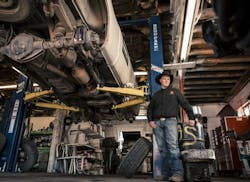The arms ascended, the chains clanked and the walls echoed the sounds of the shop’s new lift raising its very first vehicle.
And then it happened.
The screech of the rear arms bending and yelps of concern could be heard from TJ Cleveland’s office. He ran out just in time to witness his technicians scattering as the truck slid, slowly tipped and crashed to the ground. There wasn’t much else for him to do except watch in horror.
The 12,000-pound lift was supposed to be the remedy to Durango Muffler & Brake LLC’s aged 8,000-pound, two-post lift being used for one-ton pickups. And the safety concerns were only piling on top of the shop’s inefficiencies, with vehicles sitting an average of 1 hour and 25 minutes in each bay before starting.
“There were so many factors playing into [those inefficiencies] that were the direct result of my lifts,” he says.
And the safety concerns were only piling on top of the shop’s inefficiencies, with jobs taking an average of 1 hour and 25 minutes to complete.
The Backstory
As a third-generation shop owner, Cleveland’s story sounds familiar: He swept the floors of his grandfather’s shop, and worked through the ranks—from technician to service writer to manager—under his father’s ownership.
But during that time, one huge dilemma became a point of contention between Cleveland and his father: replacing that rusty 8,000-pound, two-post lift he described as “dangerous as all get-out.”
“I thought that lift was going to kill me or somebody else,” he says.
The Problem
After years of battling his father, you can imagine the frustration when Cleveland’s first big purchase (he took over Durango Muffler in January 2013) went south. Cleveland finished the job on that vehicle and worked with the customer, their insurance company and a body shop to get the required body work completed.
“We got ahold of the [lift] company, and they sent me two new rear arms,” he says. “After that, I was gun shy to pick up anything over three-quarters-ton for two years.”
The chains were wearing on his three other four-post lifts—two of which had dropped vehicles over the years when those chains snapped. In addition to equipment and toolboxes, their bulkiness made bays cramped for space. Not only was it taking longer to raise vehicles, but the posts limited room for walking and opening doors, making it nearly impossible to be efficient.
With three aging four-post lifts and the sketchy two-post, Cleveland desperately needed to rethink his layout and his buying strategy and find lifts that could truly improve his technicians’ 82 percent efficiency levels.
The Research
By June 2014, Cleveland had purchased two lifts he claims have completely turned his shop around. Here are his keys to making that decision:
Get input from technicians. Cleveland says it’s important for technicians to be involved in the research.
“I include my techs on any big equipment purchases I make because they’re the ones that have to use it,” he says.
Know your vehicle makeup. Average vehicle size was of concern to Cleveland. While his bays were large enough for your average Honda Civic, the shop’s inefficiencies really came into play with trucks.
“We work on a lot of diesel pickups, so we need to be able to get those in the building and maneuver around them without any hassle,” he says.
Measure your shop and bay dimensions. Cleveland says understanding your shop layout is the most crucial step.
“This building is 103 years old. It's been added onto and remodeled, and not one of my bay doors is the same size,” he says. “Plus I have super low clearance because our building slopes.”
According to Cleveland, the key factors to consider for lifts are ceiling height, bay width, building depth, and equipment space. Cleveland and his staff measured the biggest pickup the shop worked on—a 2013 Ford one-ton dually, four-door longbed—in each of their bays.
“We had toolboxes and parts racks and so on,” he says. “We needed to know if we had enough depth to lift up an arm safely, to be able to walk around it still, to shut the doors. With our four-posts, the arms were close enough to the doors to where if you put a four-door longbed pickup on it, you couldn’t shut the bay doors.”
Determine your inefficiencies. Cleveland decided to replace his two-post and one four-post with two new two-post lifts by tracking the shop’s amount of wheel-off work. Eighteen percent of his car count was wheel-on, meaning they could lift vehicles straight up and go under immediately; 82 percent was wheel-off for ball joint and brake work.
“I’m able to sit down and say, ‘OK, the guy is using jack stands on a four-post and slowing us down as far as efficiency.’ A car on a two-post for wheel-off work should take them an hour, but was taking an hour and 35 minutes on a four-post because they were having to set the jack stands, raise the lift up and down and up and down to do the same job on a two-post, where they could just set it, lift it, pull the tires, put the tires back on, and set it back down,” he says.
Consult other shop owners. Cleveland researched several different lifts that fit with Durango’s dimensions on bestbuyautoequipment.com. He then read hundreds of reviews through Google searches and scoured message boards. He even asked for advice on his consultant company’s networking page.
“I would sit there for hours and read reviews, see what problems people were having, what they loved about them, what they disliked about them, what they would change if they could,” he says. “Then I would go straight to the manufacturer’s website and see what they said about their lifts, because a lot of times there's a huge variance.”
One of those huge variances was dimensions, he says.
“[Manufacturers] would say the lift is ‘this tall,’ but then I would read owners saying it was three-quarters of an inch taller than what they said and they had to send it back because it wouldn’t fit in the building. [Manufacturers] would say it was ‘this width,’ but they wouldn’t take the arms into account.”
The Solution
Cleveland spent $3,250 on two new two-post lifts. He replaced his original lift purchase and his most inefficient four-post.
The Aftermath
With wheel-off work taking an average of 35 minutes less with his new two-post stalls, efficiency numbers rose from 82 to 96 percent over the course of several months. Today, technician efficiency stands at 115 percent.
With more work flowing in, Durango recouped the cost of the lift within a month, and Cleveland says his gross profit has risen by 20 percent over the past two years. The shop had its best year in 2015 with $1,000,000 in annual revenue.
Durango’s technicians are hungry to become even more efficient, resulting in a new two-post purchase to be set up over the shop’s full-length pit for semi work.
“They did the research and everything, measuring the area and finding the best options online,” Cleveland says. “I set up a bonus game, saying, ‘If you guys hit X amount of money for this many weeks in a row, I'll order the lift.’ Sure enough, they hit it, because they wanted another two-post because it makes them more efficient. They actually enjoy doing it.”
The Takeaway
A lift purchase isn’t just another piece of equipment, Cleveland says. For the team at Durango Muffler, coming together to find a lift that benefitted everyone and made the entire shop more efficient is producing more work and revenue.
“It’s actually been a great way for us to bond,” he says. “We’re a really tight-knit group after all this and I imagine we’re only going to get better as a team.”
What to do when Equipment Fails
—
As a shop management inspector for Management Success!, Jim Anderson visits dozens of shops each year. And as a shop owner himself, he’s adamant about preaching his own shop’s lift safety precautions.
You need to do your due diligence to stack the cards in your favor to keep accidents from happening. I see it as I go to shops all over the country and do inspections: They have no plan in place for their lift.
First of all, when I buy a lift, I don't put it in myself. You're just asking for trouble. Every lift that you buy, they have certified factory installers. I pay the money for them to put it in.
You also want to have them regularly serviced. What happens with a lift is a cable will start to get a little uneven. It's normal wear and tear, but if that's not adjusted properly, then things can start breaking.
I've got five lifts and it costs less than $200 a year to have them serviced each year. I call the lift manufacturers every year and have them come in, service the lifts, check the cables, hoses, look at everything, and then I file those as serviced every year. If there ever is an accident, there might be an OSHA investigation, and as the shop owner, if you can show that you have annual inspections done, you’re not liable.

